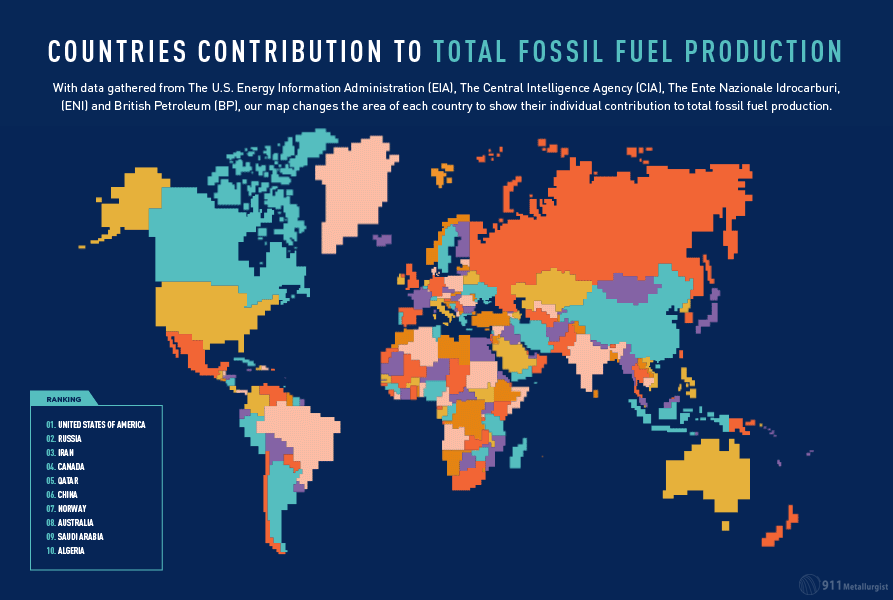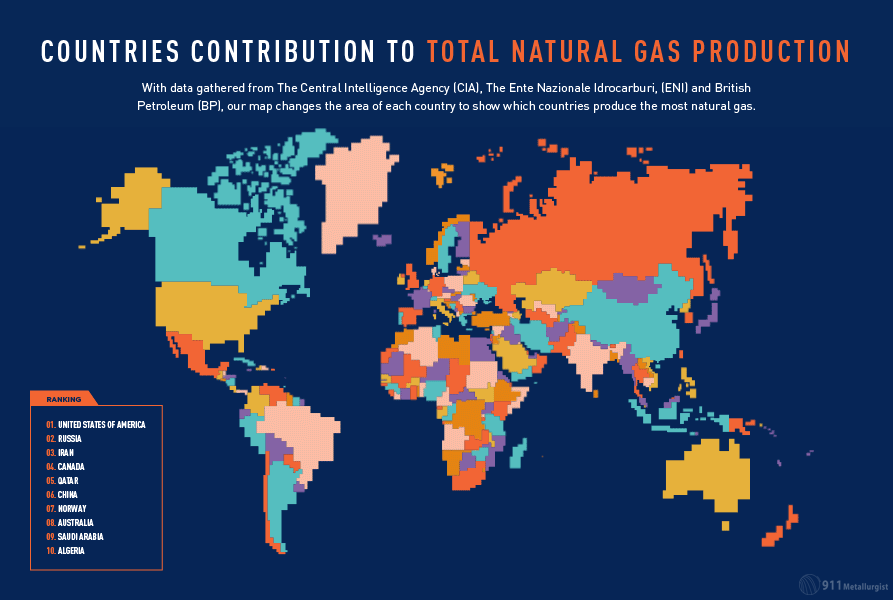
Fossil energy fueled the Industrial Revolution, resulting in enormous technological, social and economic changes across the world. These fuels (Coal, oil, and gas) continue to play a major role in global energy systems, but which country produces the most?
These maps take a closer look at fossil fuel production, country by country.
Countries contribution to total fossil fuel production
Approximately 360 to 286 million years ago, before dinosaurs, many plants and organisms filled the swamps and oceans of the Carboniferous Period. When the organisms and plants died, they sank and eventually formed different types of fossil fuels.
Nowadays, fossil fuels are the world’s dominant energy source, accounting for around 82% of the global energy supply. The USA is the biggest overall producer, producing just under 20% of all global fossil fuels, followed by Russia and Iran. Next on the list is Canada, which produces just under 5% of all fossil fuel.

Countries contribution to total oil production
Oil formed when small organisms like zooplankton and algae died and fell to the bottom of the sea. Over time, they got trapped under multiple layers of sand and mud. Intense amounts of pressure caused this complex organic matter to decompose and it eventually formed into oil. It is extracted and sold mainly as fuel.AlthoughVenezuela has the largest proven oil reserves in the world, it is only 12th in terms of oil production. The USA is the world’s biggest producer, producing 18% of the world‘s oil, followed by Saudi Arabia and Russia. Next on the list? Canada, which produces just under 6% of the world‘s oil.

Countries contribution to total natural gas production
Natural Gas underwent the same process as oil, but for a much longer period and with greater heat and pressure, which caused even more decomposition. Today, natural gas is mainly used for electricity generation, heating, and cooking. It is also used to make chemical products such as fertilizers and dyes. USA are once again top of the production list, producing nearly 20% of all natural gas. Followed in second place by Russia and then in third, Iran. Canada again comes in fourth place, producing almost 5% of the world‘s natural gas.

Countries contribution to total coal production
The first reported use of coal dates as far back as 4000BC in China. Coal is formed from ferns, plants and trees which over time have hardened due to the immense pressure and heat found underground. Coal is mostly used to generate electricity, create steel & cement and is also sometimes used as a liquid fuel. Today, China is the world’s biggest producer, producing over 45% of the world‘s coal, followed by India and then the USA. This time Canada is only the 13th biggest producer of coal, producing just under 1%.

Methodology
To create the interactive maps, we first researched what data was available on each fossil fuel. The goal was to find the most up to date and reliable data available. We selected our sources based on reliability. Countries release their data at different intervals, so to ensure accuracy we selected confirmed figures from reliable sources such as the U.S. Energy Information Administration (EIA) and the Central Intelligence Agency (CIA), among others.
The majority of our figures come from 2018 and 2017 and were the most up to date figures available from trusted sources.
Oil
Our figures were sourced from the U.S. Energy Information Administration (EIA), which has worldwide figures from 2017 and in some cases 2018. The figures are measured in thousand barrels per day.
Natural Gas
Our figures were sourced from The Central Intelligence Agency (CIA), Ente Nazionale Idrocarburi (ENI) and British Petroleum (BP). The figures are measured in billion cubic metres.
Coal
Our figures were sourced from The Central Intelligence Agency (CIA), Ente Nazionale Idrocarburi (ENI) and British Petroleum (BP). The figures are measured in thousand metric tonnes.
Total Contribution
To measure total fossil fuel contribution, we needed a standard unit of measurement. We selected metric tonnes. We then converted our original figures for oil (barrels) and natural gas (cubic meters) to metric tonnes. This enabled us to compare like for like.
EIA. (2019). Total Petroleum and Other Liquids Production.. eia.gov
CIA. (2019). The World Factbook.. cia.gov
ENI. (2018). Gas and Renewables Review 2018 Volume 2.. eni.com
B.P (2018). BP Statistical Review of World Energy 2018.. bp.com
Commonwealth of Nations. (2019). Find Oil and Gas expertise in Antigua and Barbuda.. commonwealthofnations.org
GENI. (2019). An Energy Overview of the Republic of Armenia.. geni.org
EIA. (2019). Primary Coal Production.. eia.gov
Richie, M. Roser, M. (2019). Fossil Fuels.. ourworldindata.org
OPEC. (2019). Conversion Factors.. opec.org
Qatar Petroleum. (2019). Conversion Factors.. qp.com
Kanniah, G. (2019). Fossil Fuels.. studentenergy.org
Golas, P. J, Needham, J. (1999). Science and Civilisation in China. China: Cambridge University Press
International Energy Agency. (2014). Key World Energy Statistics.. fossilfuelsreview.ed.ac.uk
Our top 6 recommended products for 2021:
1. Best Waterproof work gloves
2. Best Metal Detector for Gold
3. Best Metal Detector for Beginner
4. Best Metal Detector Pinpointer
5. Best Magnet Fishing Kit
6. Best Portable WorkBench
